A bleeding operation is necessary in order to remove air
when air is introduced into the hydraulic brake system.
Bleed the hydraulic system at all four brakes if air has been introduced
through a low fluid level or by disconnecting brake pipes at the master cylinder.
If a brake hose or brake pipe is disconnected at one wheel, bleed
only that one wheel caliper. If brake pipes or hoses are disconnected
at any fitting located between the master cylinder and the brakes,
then only bleed the brake system served by the disconnected pipe or
hose.
With Scan Tool (Preferred Method)
Refer to
Antilock Brake System Automated Bleed Procedure
in Antilock Brake System.
Without Scan Tool
Important: Do not place your foot on the brake pedal through this entire procedure
unless specifically directed to do so.
- Remove foot from the brake pedal.
- Start the engine. Allow the engine to run for at least ten seconds
while observing the amber ABS warning indicator.
- If the amber ABS warning indicator turns on and stays on after
ten seconds, stop the bleeding procedure. Use a Scan Tool in order to diagnose
the ABS malfunction.
- If the amber ABS warning indicator turns on for approximately
three seconds, then turns off and stays off, turn the ignition off.
- Repeat the previous four steps one more time.
- Bleed the entire brake system.
Brake System Pressure Bleeding Procedure
Tools Required
| • | J 29532 DiaphragmType
Brake Bleeder |
- Inspect and fill the master cylinder reservoir to the proper level
as necessary. Refer to
Master Cylinder Reservoir Filling
.
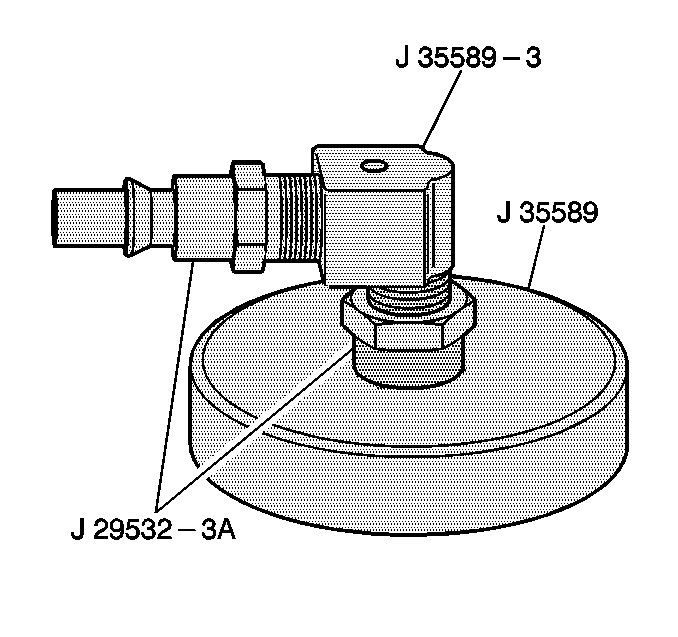
- Assemble the components
as shown.
- Install the J 35589
to the master cylinder reservoir.
- Adjust the to 35-70 kPa (5-10 psi).
- Wait approximately 30 seconds, then inspect the entire
hydraulic brake system in order to ensure that there are no existing brake
fluid leaks. Repair any brake fluid leaks.
- Adjust the to 205-240 kPa (30-35 psi).
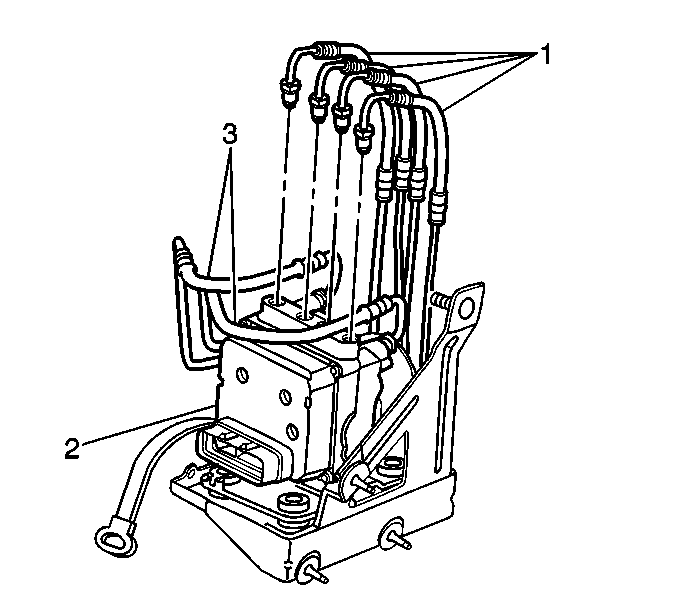
Important: Use a shop cloth in order to catch escaping brake fluid.
- Slowly open the ABS modulator brake pipe fitting (1) starting from
the first pipe on the left side in order to allow the brake fluid to flow.
Notice: Use the correct fastener in the correct location. Replacement fasteners
must be the correct part number for that application. Fasteners requiring
replacement or fasteners requiring the use of thread locking compound or sealant
are identified in the service procedure. Do not use paints, lubricants, or
corrosion inhibitors on fasteners or fastener joint surfaces unless specified.
These coatings affect fastener torque and joint clamping force and may damage
the fastener. Use the correct tightening sequence and specifications when
installing fasteners in order to avoid damage to parts and systems.
- Close the ABS modulator brake pipe fitting
when air bubbles are no longer detected in the brake fluid.
Tighten
Tighten the ABS modulator brake pipe fitting to 24 N·m
(18 lb ft).
- Repeat Steps 8 and 9 for the remaining ABS modulator brake
pipe fittings.
- Raise and suitably support the vehicle. Refer to
Lifting and Jacking the Vehicle
in General Information.
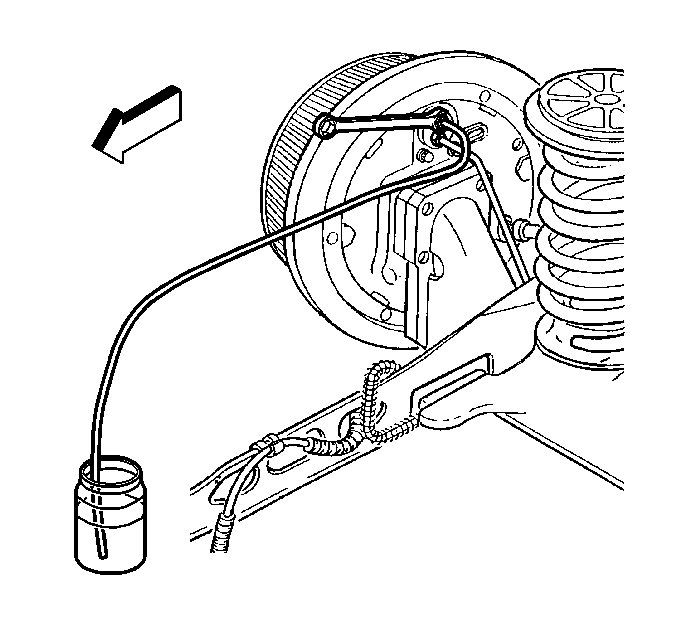
- Install the clear plastic
bleeder hose to the RIGHT REAR bleeder valve:
| • | For DOMESTIC vehicles, install the clear plastic bleeder hose
to the wheel cylinder bleeder valve. |
| • | For EXPORT vehicles, install the clear plastic bleeder hose to
the brake caliper bleeder valve. |
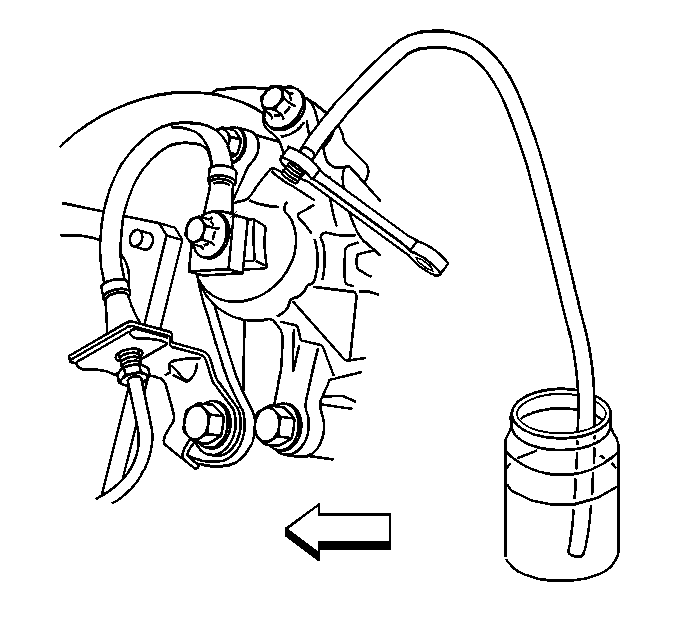
- Submerge the opposite
end of the clear plastic bleeder hose in a clean container partially filled
with clean brake fluid.
- Slowly open the bleeder valve in order to allow the brake fluid
to flow.
- Close the bleeder valve when air bubbles are no longer detected
in the brake fluid.
Tighten
| • | For DOMESTIC vehicles, tighten the wheel cylinder bleeder valve
to 7 N·m (62 lb in). |
| • | For EXPORT vehicles, tighten the wheel cylinder bleeder valve
to 11 N·m (97 lb in). |
- Remove the clear plastic bleeder hose from the bleeder valve.
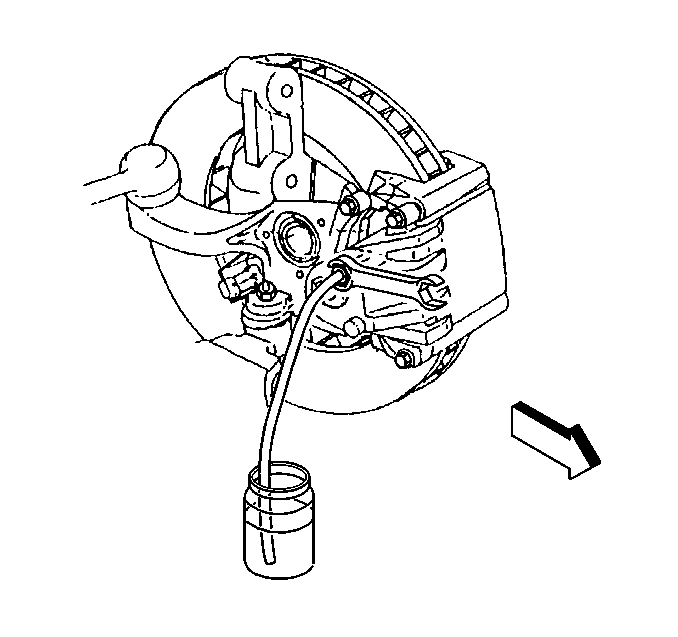
- Install the clear plastic
bleeder hose to the LEFT FRONT brake caliper bleeder valve.
- Submerge the opposite end of the clear plastic bleeder hose in
a clean container partially filled with clean brake fluid.
- Slowly open the bleeder valve in order to allow the brake fluid
to flow.
- Close the bleeder valve when air bubbles are no longer detected
in the brake fluid.
Tighten
Tighten the brake caliper bleeder valve to 13 N·m (115 lb in).
- Remove the clear plastic bleeder hose from the bleeder valve.
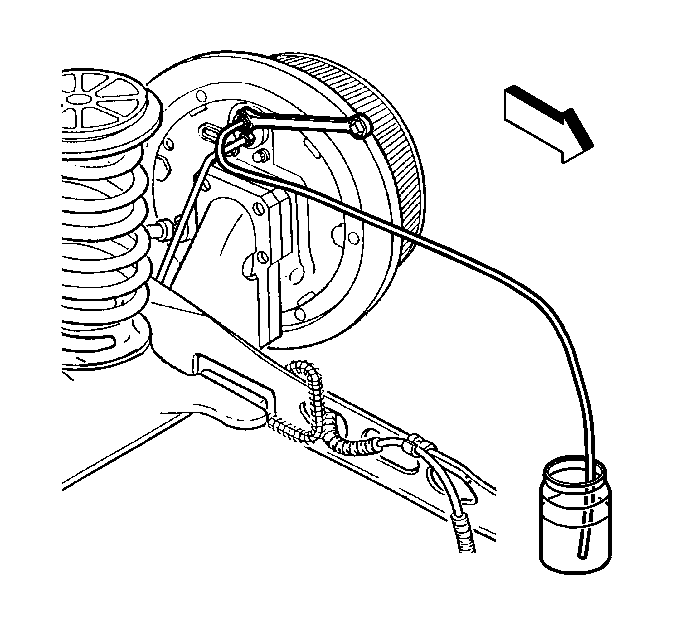
- Install the clear plastic
bleeder hose to the LEFT REAR bleeder valve.
| • | For DOMESTIC vehicles, install the clear plastic bleeder hose
to the wheel cylinder bleeder valve. |
| • | For EXPORT vehicles, install the clear plastic bleeder hose to
the brake caliper bleeder valve. |

- Submerge the opposite
end of the clear plastic bleeder hose in a clean container partially filled
with clean brake fluid.
- Slowly open the bleeder valve in order to allow the brake fluid
to flow.
- Close the bleeder valve when air bubbles are no longer detected
in the brake fluid.
Tighten
| • | For DOMESTIC vehicles, tighten the wheel cylinder bleeder valve
to 7 N·m (62 lb in). |
| • | For EXPORT vehicles, tighten the wheel cylinder bleeder valve
to 11 N·m (97 lb in). |
- Remove the clear plastic bleeder hose from the bleeder valve.
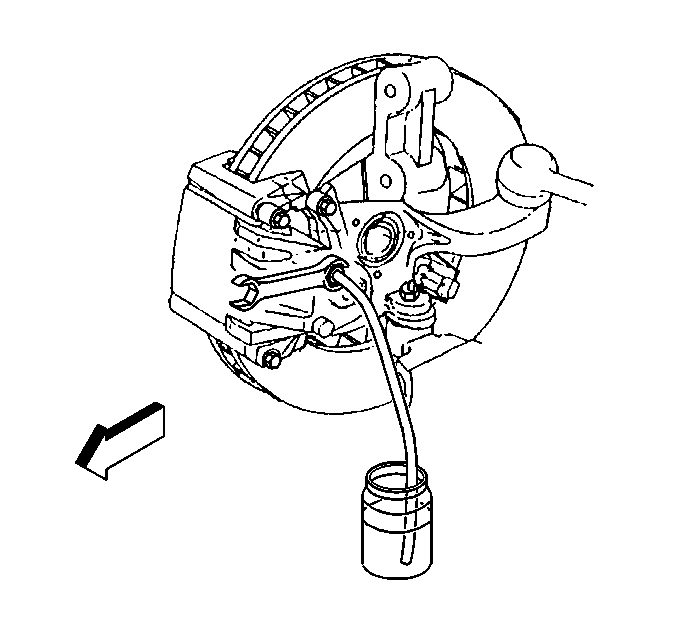
- Install the clear plastic
bleeder hose to the RIGHT FRONT brake caliper bleeder valve.
- Submerge the opposite end of the clear plastic bleeder hose in
a clean container partially filled with clean brake fluid.
- Slowly open the bleeder valve in order to allow the brake fluid
to flow.
- Close the bleeder valve when air bubbles are no longer detected
in the brake fluid.
Tighten
Tighten the brake caliper bleeder valve to 13 N·m (115 lb in).
- Remove the clear plastic bleeder hose from the bleeder valve.
- Lower the vehicle.
- Remove the J 35589
from the master cylinder reservoir.
- Inspect and fill the master cylinder reservoir to the proper level
as necessary.
- Install the master cylinder reservoir cap.
- Start the engine and allow the engine to run for at least 10 seconds.
- Turn the ignition OFF.
- Inspect the brake pedal feel and the brake pedal travel.
| • | If the brake pedal feels firm and constant and the brake pedal
travel does not exceed specifications, proceed to Step 39. |
| • | If the pedal feels soft or the brake pedal travel exceeds specifications,
DO NOT DRIVE THE VEHICLE. Go to Step 40. |
- Start the engine and inspect the brake pedal feel.
| • | If the brake pedal still feels firm, got to Step 42. |
| • | If the brake pedal feels soft, DO NOT DRIVE THE VEHICLE. proceed
to Step 40. |
- Use the scan tool in order to perform the automated bleed procedure.
Refer to in
Antilock Brake System Automated Bleed Procedure
Antilock
Brake System.
- Ensure that the unacceptable brake pedal feel/travel is not caused
by misadjusted brake linings or other mechanical failures, then repeat the
Brake System Pressure Bleeding procedure. Proceed to Step 1.
- Road test the vehicle. Make several normal (non-ABS) stops from
a moderate speed in order to ensure proper brake system function. Allow adequate
brake system cooling time between stops.
Brake System Manual Bleeding Procedure
Important: This procedure may require the help of an assistant to apply the brake
pedal while the bleeder valves are opened and closed.
Important: Ensure that the master cylinder brake fluid level does not drop to the
bottom of the master cylinder reservoir. You will be instructed to Inspect
and fill the master cylinder reservoir at times during this procedure.
However, the actual frequency of master cylinder reservoir filling
REQUIRED will depend on the amount of fluid that is released. If the
brake fluid level drops to the bottom of the master cylinder reservoir,
start the bleed procedure again at Step 1.
- Inspect and fill the master cylinder reservoir to the proper level
as necessary.

Important: Use a shop cloth in order to catch escaping brake fluid.
- Slowly open the ABS modulator brake pipe fitting (1) starting
from the first pipe on the left side in order to allow the brake fluid to
flow.
- Press and hold the brake pedal approximately 75 percent
of a full stroke.
Notice: Use the correct fastener in the correct location. Replacement fasteners
must be the correct part number for that application. Fasteners requiring
replacement or fasteners requiring the use of thread locking compound or sealant
are identified in the service procedure. Do not use paints, lubricants, or
corrosion inhibitors on fasteners or fastener joint surfaces unless specified.
These coatings affect fastener torque and joint clamping force and may damage
the fastener. Use the correct tightening sequence and specifications when
installing fasteners in order to avoid damage to parts and systems.
- Close the ABS modulator brake pipe fitting
when air bubbles are no longer detected in the brake fluid.
Tighten
Tighten the ABS modulator brake pipe fitting to 24 N·m
(18 lb ft).
- Repeat Steps 2 and 3 for the remaining ABS modulator brake
pipe fittings.
- Inspect and fill the master cylinder reservoir to the proper level
as necessary.
- Raise and suitably support the vehicle. Refer to
Lifting and Jacking the Vehicle
in General Information.

- Install the clear plastic
bleeder hose to the RIGHT REAR bleeder valve.
| • | For DOMESTIC vehicles, install the clear plastic bleeder hose
to the wheel cylinder bleeder valve. |
| • | For EXPORT vehicles, install the clear plastic bleeder hose to
the brake caliper bleeder valve. |

- Submerge the opposite
end of the clear plastic bleeder hose in a clean container partially filled
with clean brake fluid.
- Open the bleeder valve.
- Press and hold the brake pedal approximately 75 percent
of a full stroke.
- Close the bleeder valve.
- Release the brake pedal.
- Repeat Steps 10 through 13 until air bubbles are no longer
detected in the brake fluid.
Tighten
| • | For DOMESTIC vehicles, tighten the wheel cylinder bleeder valve
to 7 N·m (62 lb in). |
| • | For EXPORT vehicles, tighten the wheel cylinder bleeder valve
to 11 N·m (97 lb in). |
- Remove the clear plastic bleeder hose from the bleeder valve.

- Install the clear plastic
bleeder hose to the LEFT FRONT brake caliper bleeder valve.
- Submerge the opposite end of the clear plastic bleeder hose in
a clean container partially filled with clean brake fluid.
- Open the bleeder valve.
- Press and hold the brake pedal approximately 75 percent
of a full stroke.
- Close the bleeder valve.
- Release the brake pedal.
- Repeat Steps 18 through 21 until air bubbles are no longer
detected in the brake fluid.
Tighten
Tighten the brake caliper bleeder valve to 13 N·m (115 lb in).
- Remove the clear plastic bleeder hose from the bleeder valve.

- Install the clear plastic
bleeder hose to the LEFT REAR bleeder valve.
| • | For DOMESTIC vehicles, install the clear plastic bleeder hose
to the wheel cylinder bleeder valve. |
| • | For EXPORT vehicles, install the clear plastic bleeder hose to
the brake caliper bleeder valve. |

- Submerge the opposite
end of the clear plastic bleeder hose in a clean container partially filled
with clean brake fluid.
- Open the bleeder valve.
- Press and hold the brake pedal approximately 75 percent
of a full stroke.
- Close the bleeder valve.
- Release the brake pedal.
- Repeat Steps 26 through 29 until air bubbles are no longer
detected in the brake fluid.
Tighten
| • | For DOMESTIC vehicles, tighten the wheel cylinder bleeder valve
to 7 N·m (62 lb in). |
| • | For EXPORT vehicles, tighten the wheel cylinder bleeder valve
to 11 N·m (97 lb in). |
- Remove the clear plastic bleeder hose from the bleeder valve.

- Install the clear plastic
bleeder hose to the RIGHT FRONT brake caliper bleeder valve.
- Submerge the opposite end of the clear plastic bleeder hose in
a clean container partially filled with clean brake fluid.
- Open the bleeder valve.
- Press and hold the brake pedal approximately 75 percent
of a full stroke.
- Close the bleeder valve.
- Release the brake pedal.
- Repeat Steps 34 through 37 until air bubbles are no longer detected
in the brake fluid.
Tighten
Tighten the brake caliper bleeder valve to 13 N·m (115 lb in).
- Remove the clear plastic bleeder hose from the bleeder valve.
- Lower the vehicle.
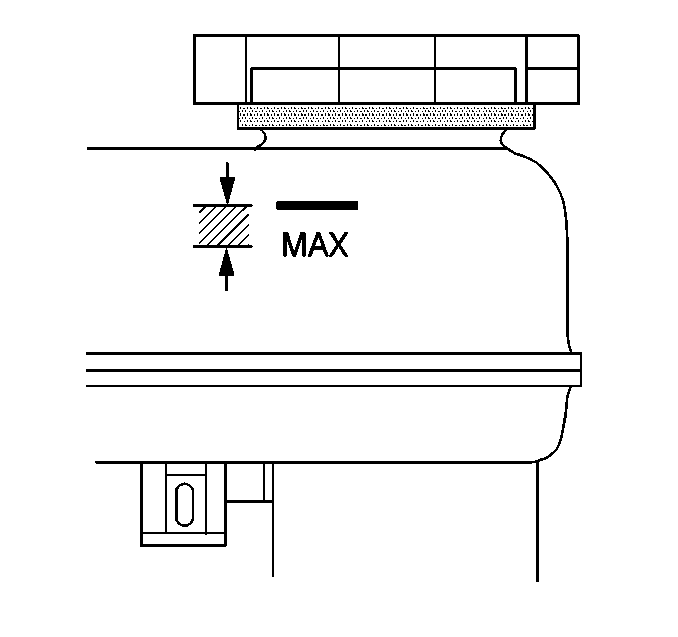
- Remove the brake fluid
reservoir cover.
- Inspect the brake fluid level in the reservoir.
- Install the brake fluid reservoir cover.
- Turn the ignition switch to the RUN position, then turn off the
engine. Apply the brake pedal with moderate force and hold the pedal. Note
the pedal travel and feel.
- If the pedal feels firm and constant and pedal travel is not excessive,
start the engine. With the engine running, recheck the pedal travel.
- If the pedal feel is still firm and constant and pedal travel
is not excessive, perform a vehicle road test. Make several normal (non-ABS)
stops from a moderate speed in order to ensure proper brake system function.
- If pedal feel is soft or has excessive travel either initially
or after engine start, refer to in Antilock Brake System.
- Repeat the manual bleeding procedure, starting at Step 1.
- Perform a vehicle road test. Make several normal (non-ABS) stops
from a moderate speed in order to ensure proper brake system function.
















